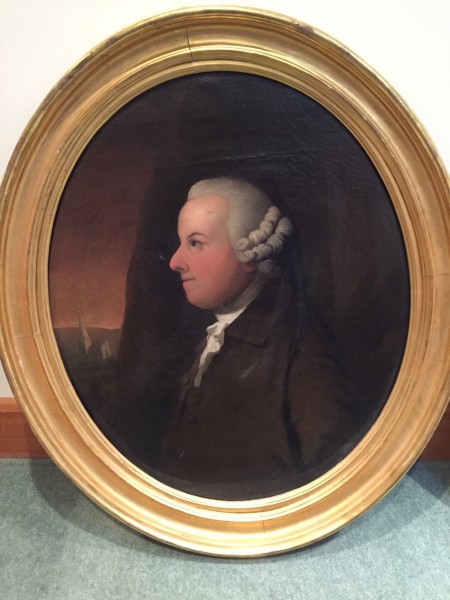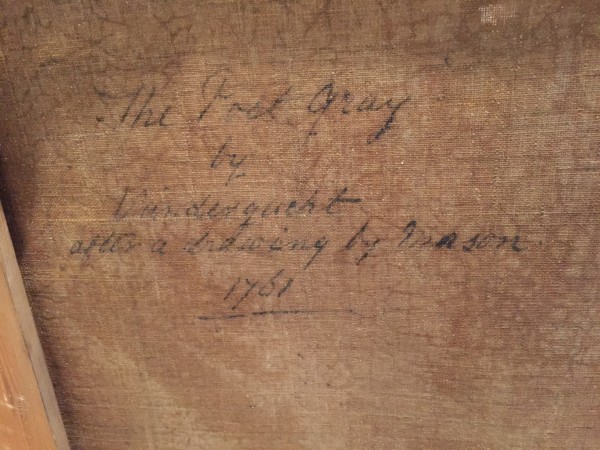FDA-P.575-2018
Parts
Object number
FDA-P.575-2018
Object type
Identification
Title
Thomas Gray
Title Type
assigned by cataloguer
Comments
The poet William Mason (1724–1797) was a friend of Thomas Gray (1716–1771). He made the earliest known portrait of Gray: a profile sketch (now at Pembroke College, Cambridge). After Gray’s death, Mason commissioned a posthumous portrait from Benjamin Wilson (c.1721–1788), which was painted in 1771–72. While Wilson was engaged on the project, Mason helpfully sent the artist his own portrait sketch, as well as a small oil portrait of Gray. Mason bequeathed the resulting portrait to another friend, Richard Stonhewer (1728[?]–1809), who went on to bequeath the work to Pembroke College.
This painting is a copy of Benjamin Wilson’s portrait for Mason. The composition differs in that it is oval, rather than rectangular, but it similarly shows Gray before a brown rock or tree trunk, with a landscape including a church with a spire in the distance. The history of this work is explained by Sir George Scharf (1820–1895), a director of the National Portrait Gallery, in an article of 1894 for ‘The Athenaeum’:
'From [the Wilson] painting an exact copy was taken by Benjamin Vander Gucht for Lord Harcourt at Nuneham Courtenay. It still adorns the library there. Benjamin Vander Gucht, grandson of a distinguished engraver, was greatly employed in large houses. He painted original portraits, made copies, restored pictures and was besides a dealer. He cleaned and repaired Lord Burlington’s pictures at Chiswick, and made many copies of original portraits for Nuneham and Althorp. He was accidentally drowned in crossing the Thames at night.'
When there was a sale of Nuneham House and its contents in 1948, Gray’s portrait did not sell and how it left the Hardwick collection has yet to be ascertained.
This painting is a copy of Benjamin Wilson’s portrait for Mason. The composition differs in that it is oval, rather than rectangular, but it similarly shows Gray before a brown rock or tree trunk, with a landscape including a church with a spire in the distance. The history of this work is explained by Sir George Scharf (1820–1895), a director of the National Portrait Gallery, in an article of 1894 for ‘The Athenaeum’:
'From [the Wilson] painting an exact copy was taken by Benjamin Vander Gucht for Lord Harcourt at Nuneham Courtenay. It still adorns the library there. Benjamin Vander Gucht, grandson of a distinguished engraver, was greatly employed in large houses. He painted original portraits, made copies, restored pictures and was besides a dealer. He cleaned and repaired Lord Burlington’s pictures at Chiswick, and made many copies of original portraits for Nuneham and Althorp. He was accidentally drowned in crossing the Thames at night.'
When there was a sale of Nuneham House and its contents in 1948, Gray’s portrait did not sell and how it left the Hardwick collection has yet to be ascertained.
Description
Content (person)
Gray, Thomas, 1716 - 1771 (Sitter)
Dimensions
height (frame): 915mm
width (frame): 790mm
depth (frame): 80mm
height (sight size): 730mm
width (sight size): 610mm
width (frame): 790mm
depth (frame): 80mm
height (sight size): 730mm
width (sight size): 610mm
Inscription
Inscribed in black paint on the back of the canvas: 'The Poet Gray / by / Vandergucht / after a drawing by Mason / 1761'
Material
oil paint
canvas
canvas
Materials & techniques note
Oil on canvas
Production
Person
Date
1770-1794
History and association
Object history note
Provenance: Collection of William Edward Harcourt, 2nd Viscount Harcourt (1908-1979) of Nuneham Park, Oxfordshire; by whom sold through Christie's, London, 'Pictures of Old Masters and Historical Portraits', on 11 June 1948 (Lot 185); bought in;; collection of Robert Lloyd George; by whom presented to Eton College in c.2001













